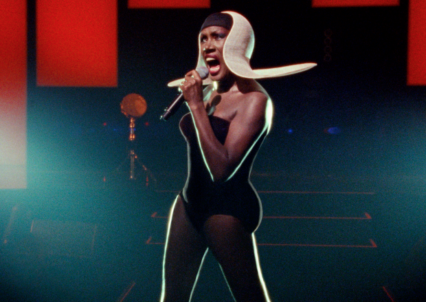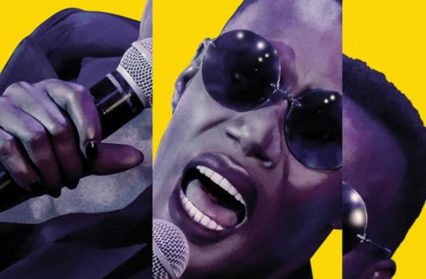Filmed over the course of a decade Bloodlight and Bami, the new documentary about Grace Jones from director Sophie Fiennes offers a stylish and unconventional look at the Jamaican-born model, singer, and New Wave icon. Craig Austin gets up-close and personal with the artist at the BFI at the film’s nationwide premiere.
‘My mother was the Williams, my father the Jones’, the artist reflects, in a moment that at one time would have caused Wales on Sunday to frantically trawl through its historical records in an attempt – hello, Kylie! – to tenuously claim Miss Grace Jones for the nation. And though much of Bloodlight and Bami is rooted in familial and national heritage, it is one firmly entrenched in the culture, customs and inimitable bass-boom of Jamaica.
In Sophie Fiennes’ revelatory documentary the combination of bloodlight (Jones’s art) – the red light of the recording studio – and bami (her life) – Jamaica’s traditional flatbread – conspire to construct a captivating duality between the artist and the motivational experiences that shaped her escapist ambition. Not least the memories that are evoked by the sombre family discussions about her violent step-grandfather ‘Mas P’, a man whose fiercely steely glare Jones feels she inadvertently replicates on stage in spite of her self-styled ‘Williams blood’ – ‘the male dominant scary person I become’. A subsequently stylised image that still defines the artist in the eyes of the public and the embodiment of the character portrayed within the lyrics of her own magnificent Walking in the Rain: Feeling like a woman / Looking like a man
Filmed primarily around and about the creation of her 2008 comeback album, Hurricane, Fiennes’ quietly unobtrusive yet sharply enlightening work reveals an artist who appears to be as at ease eating fried fish out of a plastic basket in the modest home of her extended Jamaican family as she is chugging champagne for breakfast in the swankiest of Parisian hotel suites. Jones refuses to be constricted by notions as limiting as either class or convention, an approach to life perhaps best exemplified by a truly joyous scene in which Jones sashays around her kitchen singing loudly along to her own song This Is, as she spoons shallot vinaigrette onto a bountiful plate of fresh oysters: This is my voice / My weapon of choice
 Fiennes punctuates these scenes with relatively contemporary concert footage that underlines the power and spectacle of Jones the performer, without ever resorting to plundering the archive for recordings from the artist’s 80s commercial peak; a welcome decision given its sheer futility. Aside from the fact that she resolutely refuses to succumb to the ageing process , at 69 years old Grace Jones remains the unapologetic embodiment of pop-art innovation, a woman so modern that everything else seems either redundant or insignificant by comparison. ‘Do you ever worry about being able to meet you audience’s expectations?’, a journalist innocently enquires of the artist, only to be met with the most Grace-ious of responses: ‘I have much higher expectations than they do’
Fiennes punctuates these scenes with relatively contemporary concert footage that underlines the power and spectacle of Jones the performer, without ever resorting to plundering the archive for recordings from the artist’s 80s commercial peak; a welcome decision given its sheer futility. Aside from the fact that she resolutely refuses to succumb to the ageing process , at 69 years old Grace Jones remains the unapologetic embodiment of pop-art innovation, a woman so modern that everything else seems either redundant or insignificant by comparison. ‘Do you ever worry about being able to meet you audience’s expectations?’, a journalist innocently enquires of the artist, only to be met with the most Grace-ious of responses: ‘I have much higher expectations than they do’
Expectations, and personal standards, are core to what it means to be Grace Jones, principles best demonstrated by a somewhat acrimonious appearance on a trashy French TV show in which she is slyly duped into performing La Vie en Rose while surrounded by a vacant troupe of dead-eyed lingerie-clad dancers. ‘I feel like a madam in a brothel!’ she exclaims to the camera, her eyes shrouded by some exceptional millinery which she has resolutely refused to remove despite the insistence of the show’s furtive producer. ‘Do you not have any male dancers?’ Jones demands of him. ‘This is against what I stand for!’ Yet even in this moment the artist’s humanity shines through, not least in her evident desire not to hurt the dancers’ feelings.
Fiennes’ sequencing criss-crosses both globe and calendar and portrays the artist alternating between the patois of her Jamaican heritage, the languid Manhattan drawl of her 80s imperial phase, and the fluent French that is the legacy of her time as a one-time Parisian. Jones’s status as a citizen of the world notwithstanding, her instinctive desire is to assimilate and integrate at every opportunity. A revelation of human authenticity that may well disappoint those who revere her extra-terrestrial ‘otherliness’ above all else, but one which proves to be the most welcome reveal of the film’s 120 minutes.
In this spirit, it feels appropriate that when Jones takes to the stage of the BFI after the first nationwide screening of Bloodlight and Bami it’s apparent to all present that she has ‘had a few’. Compere, Paul Morley, who rightly welcomes her to stage as ‘Grace. Fucking. Jones’ clocks this immediately and is so determined to remain on his interviewing mettle that, in what must be a first, he completely fails to make a legitimate Joy Division connection. In this instance, Jones’s electro-skank take on the band’s seminal ‘She’s Lost Control’.
In conversation, we learn that Jones views the passing of time in terms of space rather than age, that she secretly desires to perform cunnilingus on the director, and that almost any eccentric nuance of the English language can be guaranteed to be perceived as a sexual innuendo by the Jamaican woman in the elaborate black headgear that has almost certainly been inspired by Frank, the Donnie Darko rabbit.
As we slowly file out of the auditorium, Morley finds himself in a headlock entirely of the artist’s making, the final denouement of a conversation that he relinquished ownership of some time ago. That infamous ‘Williams blood’ has won through yet again.











